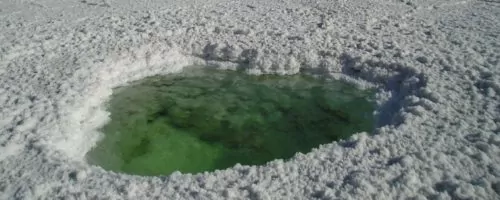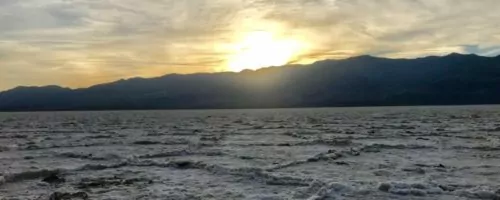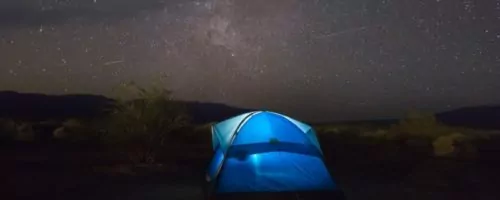
Badwater Basin
General Description
The high point of any trip to Death Valley National Park just might be a visit to the lowest place in North America, Badwater Basin. From 280 feet below sea level, park visitors can stroll out onto an endless pan of glowing white salt. Telescope Peak looms 11,000 above Badwater Basin to the southwest and Dante’s View, just over a vertical mile straight up to the east. There’s more to appreciate than just the immensity of the landscape. Further out on the salt flats, away from trampling feet are salt crystal polygons as unique and numerous as snowflakes in a blizzard. Badwater Basin has no defined trail, so explore to your heart’s content. Just be aware that the fragile salt pools are off-limits to everyone. Be sure to carry plenty of water and enjoy this iconic wonder of Death Valley.
Explore Death Valley with Expert Guides
Getting to Badwater Basin
From CA-190, turn south onto Badwater Basin Road. The parking area at Badwater Basin will be on the right 16.5 miles south of the turnoff. If the parking area is full, there is additional roadside parking to the north and south. Be sure to park completely off the road in a designated turnout and watch for oncoming traffic.
The Lowdown on Badwater Basin
At 282 feet below sea level, Badwater Basin is the lowest point in North America. Here’s the kicker, it is still sinking! Badwater Basin is located along the Southern Death Valley Fault. Normal (vertical) movement of this fault results in an uplift of the Black Mountains to the east and a dropping of the valley floor. Typically, erosion from the surrounding mountain ranges would fill this sedimentary basin faster than it could sink. Death Valley’s average precipitation of less than 2 inches per year hardly causes enough erosion to make up for the rate of drop. Despite the slow rate of deposition, visitors at Badwater Basin are still standing atop over 11,000 feet of accumulated sediment and salt!
Please, Pass the Salt
At first glance, Badwater Basin may appear to be covered in a pristine blanket of pure white snow. A closer inspection will reveal a massive pan of 95% pure NaCl (table salt)! This crust of salt is all that remains of the once mighty Lake Manly that filled the entirety of Death Valley. Periodically, heavy rain events will fill the basin with a shallow layer of water, but it doesn’t last long. 2 inches of precipitation per year is hardly enough to keep up with an average evaporation rate of 150 inches per year. That means that a lake 12 feet deep in Death Valley would disappear in less than a year. All that is left after these rare flood events is a smooth layer of pure white salt.

3 Best Day Hikes Near Badwater Basin
After taking in the vast expanse of the Badwater Basin salt flats, check out these nearby hikes to make the most of your visit to Death Valley National Park.
| Destination | Miles | Elev | Difficulty | Style | |
| Artist Drive | 0-1 mi | <100 ft | Easy | Out and Back | |
| Desolation Canyon | 3.5 mi | 750 ft | Moderate | Out and Back | |
| Sidewinder Canyon | 4-6 mi | 1000 ft | Moderate | Out and Back |
1. Artist Drive
Artist Drive is without a doubt the most colorful and unique experience in Death Valley National Park. This 9 mile drive gets park visitors up close and personal with some of Death Valley’s vibrantly colored mineral deposits. The main stop along Artist Drive is Artist’s Palette. Here, hikers can cross a shallow wash and meander through small canyons between crumbling piles of pink, purple, blue, green, red, and brown volcanic deposits. Colors mix and contrast so sharply, it’s easy to imagine that you are walking on the palette of a grand artist. Explore as far or as short as you would like. There is fun for everyone along Artist Drive.
2. Desolation Canyon
If you’re looking for a top-notch entry level cross country trail, Desolation Canyon comes in at the top of the class. Far less popular than nearby Golden Canyon and Gower Gulch, Desolation Canyon is a family-friendly, fun-filled, route finding hike. Trek cross country picking your entry into the shallow wash that will soon rise around you into a beautiful wineglass shaped canyon. Not long after the walls close in, hikers are faced with a few short dry fall scrambles to rouse that intrepid spirit. As a reward for your effort, the canyon puts on display stunning pinks, reds, purples, blues, and greens, reminiscent of the nearby Artist’s Palette. Take a little time to explore some of Desolation’s many short side canyons. The pinnacle of the hike is a ridgetop view of Artist Drive and sweeping Death Valley vistas. Desolation Canyon is sure to charge up your sense of adventure.
3. Sidewinder Canyon
If you want to experience the slot canyons of Death Valley National Park, then look no further. The slots of Sidewinder Canyon are as twisting and tortuous as their namesake. A moderate hike up the inclined wash delivers hikers past mysterious and intriguing side slot canyons to the delicately carved narrows. Beyond the narrows, smoothly polished chutes and dry falls of smoothly polished schist impede further upstream passage. The real fun is exploring any of the 6 narrow slots that suddenly appear like hidden passageways on either side of the canyon. Snaking your way up these dark narrow halls feels, at times, like a spelunking expedition. After some fun-filled scrambling, it is a gentle stroll back down the gravelly wash. The hike back is filled with the magnificent panorama of the Badwater salt pan backed by the majestic Panamint Mountains making Sidewinder Canyon an unbelievable Death Valley excursion.
Maximize Your Visit to Death Valley National Park on a Hiking Tour
Guided multi-day packages allow visitors the opportunity to make the most of their time in Death Valley National Park and to do it hassle-free. Guided tours include gear (backpack, trekking poles, crampons in winter), meals, accommodations, local transportation, and a professional Death Valley hiking guide. Through their knowledge, stories, and personal passion, guides can bring a place to life in a way that’s much more difficult to do on your own. Read more about Death Valley Hiking Tours.
Award Winning USA Hiking Vacations

Join a Guided Death Valley National Park Backpacking Trip
Joining a Death Valley backpacking tour is a worry-free, adventurous way to experience Death Valley National Park. With your gear, meals, local transportation, permits, and fees taken care of for you, you can travel light and focus 100% on enjoying the hiking experience, while the guide company takes care of everything else. Also, by going with local experts you’ll enjoy a greater level of safety and gain a much better understanding of the history and ecology of this remarkable region. Read more about a guided Death Valley National Park backpacking trip.

When to Hike and Seasonal Considerations
Badwater Basin is accessible year-round, but it is best hiked from late fall to early spring. It is best to avoid hiking past 10 am during the rest of the year as the extreme heat can be dangerous. It is also ill-advised to attempt hiking across the salt pan. The opposite side of the valley is deceptively far away and the salt crust may be very thin further out on the flats. Always bring plenty of water and hydrate with frequent small sips. Sunrise and sunset can be particularly sublime from the salt flats. Go for a full moon hike for an absolutely surreal night hiking experience.
Necessary Permits
Day Hikes
No permits are required for day hiking in Death Valley National Park.
Backpacking Permits
Backcountry camping permits are voluntary and may be obtained at the Visitor Center or any Ranger Station. Due to the extreme environment and remoteness, it is recommended that solo hikers and backpackers provide itinerary information and emergency contacts to park personnel.
Suggested Packing List
Day Hike Packing List
- 3-4 liters of water per person
- Salty, calorie-rich snacks
- lunch
- backpack
- trekking poles
- crampons (in winter)
- wide-brimmed hat
- sunscreen, sunglasses
- cotton t-shirt (spring-fall)
- non-cotton t-shirt (winter)
- rain jacket
- warm non-cotton layer
- 1st-aid kit
Backpacking Packing List
- all items listed for day hikes PLUS
- additional water AND water filter/purification method
- multi-day backpack
- 3-season tent
- sleeping bag
- sleeping pad
- backpacking stove and fuel
- backpacking meals
- 2-3 pairs wool socks
- extra t-shirts
Please Respect Our National Parks – Leave No Trace
We strongly recommend abiding by all Leave No Trace ethics guidelines and practices so that our national parks and public lands are preserved for the enjoyment of future generations and for the people and animals who call these places home. Simple things like packing out your trash, obeying national park rules, and respecting the peace and quiet of our national park trails is a great start. If you’re going on a backpacking trip, you can read about more about the 7 Leave No Trace Principles.




